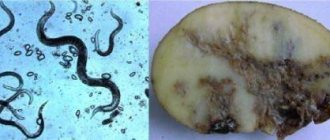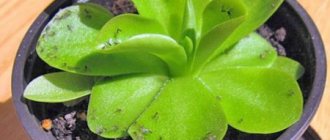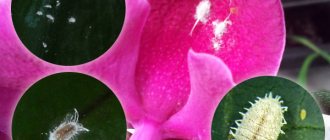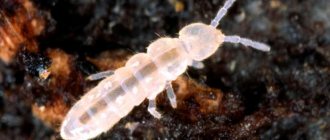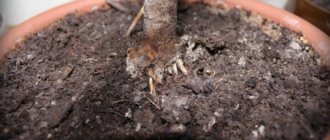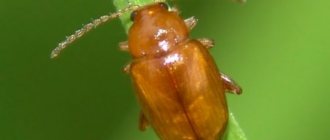Share on social media networks:
Growing vegetables, berries, and fruits with your own hands is not just the right attitude towards your own health, because as a result you can get a bountiful harvest from environmentally friendly fruits. For many, farming is also a kind of hobby, a pleasant and interesting vacation. The only thing that can sadden the owners of dachas and gardens is the appearance of pests, for example, the earthen fly, the fight against which causes a lot of trouble. There are different types of this insect that prefer to eat different crops. You will learn about what they are and how to effectively deal with them in this article.
Types of groundfly
Depending on what plants this enemy likes to feed on, the following types of ground flies are distinguished:
- carrot;
- onion;
- cabbage
Important! Each of them requires a special approach. So, if it is a carrot ground fly, the fight against it will be different from a flower fly or any other. For information on what effective methods exist for exterminating these pests and how to properly use certain drugs in the fight against earth flies, see below.
Whiteflies in flower pots
However, white midges also often appear in flower pots. Typically, these insects belong to the family of small Homoptera (lat. Homoptera) and are called greenhouse whiteflies.
In total there are about 1550 species, some of them are quarantine species.
Whiteflies are 2 mm long insects with two pairs of white wings. In addition to potted flowers, they also often attack plants grown in greenhouse conditions.
Whitefly larvae live on the undersides of leaves, sucking the juice from them. As a result, the leaves turn yellow, which causes chlorosis and subsequent leaf drop.
We have prepared an interesting article about mushrooms on the lawn.
Is it difficult to make a fragrant flower garden? Our answer is already ready for you.
English flower beds. https://sad-doma.net/landshaftnyj-dizajn/aromatnye-anglijskie-klumby.html Read about this volume here.
Carrot earth fly - fight
The carrot fly is one of the worst enemies of this healthy and tasty crop. What is typical is that one year you can see only a few individuals on your site, and the next year there will be a whole invasion of insects. What exactly is the reason for such a clear difference in the population is still unknown.
Important! This insect has a black body 5-7 mm long and transparent wings. The carrot fly lays its larvae deep in the root crops themselves, which in case of a large harvest are stored along with healthy vegetables. In the spring, the larvae wake up, gnaw their way out of the vegetable and begin to spoil your harvest and actively reproduce. Considering these factors, it is easy to understand that the earth fly is a malicious enemy, the fight against which must be quite cruel and effective.
How to identify a carrot fly?
Signs that your garden has been attacked by a ground fly, the fight against which must begin immediately, are the following changes in the plants:
- the leaves acquire a bronze tint, then red-violet, yellow;
- the plant withers and dies, despite the fact that you provided it with proper care;
- the fruits are thoroughly eaten and have a bitter taste.
Important! Such pests appear on the site in early May. Moreover, during the summer period it manages to lay multiple eggs several times.
Carrot earth fly - control, preparations
The modern chemical industry is making great strides in the fight against various types of pests. The ground fly was no exception. If you prefer to get rid of any unwanted “guests” in your garden as quickly as possible and are ready to use special preparations for this, the following will suit you:
- Zieper, K.E.;
- Decis Profi, VDG;
- Shar Pei, ME
- Arrivo, K.E.; Vega, K.E.;
- Inta-Vir, VRP;
- Aklellik, K.E.;
- Fitoverm.
Important! Spray only when the average daily temperature is not lower than 20C, only in the morning or evening. The concentration of each drug varies, so please read the manufacturer's instructions carefully before use.
Folk measures to combat carrot fly
If you decide to give up chemicals to combat earth flies, adopt the following folk methods:
- Sprinkle dry mustard or tobacco dust between the beds.
- Plant wormwood and yarrow nearby, and lay out tomato tops.
- Spray the green top with one of the following solutions:
- Garlic or onion tincture. To do this you will need 200g of vegetable and 2 liters of warm water. Pour finely chopped garlic or onion with water, leave for 1 day, strain, mix with 8 liters of water. If desired, you can add a little liquid soap.
- Pine tincture. Buy 200g of any pine needle extract and dilute it with 10 liters of water.
- Decoction of tomato tops. For this you will need about 4 kg of raw materials and 10 liters of water. Boil the tops in water for about half an hour after boiling and leave for 3 hours. The resulting decoction is mixed with water in a ratio of 1:3 before spraying.
Prevention of the appearance of ground carrot fly
To avoid attracting these pests, grow carrots correctly, adhering to the following rules:
- Do not apply fresh manure to the beds.
- Alternate beds of carrots and onions - the aroma of the second plant is extremely unpleasant for this fly.
- Sow the crop very early so that the seedlings have time to get stronger.
- Remove all thinned plants away from beds with growing carrots - the aroma of such shoots is very attractive to the females of this enemy.
- Use peat as mulch.
- Water the soil moderately, and in the period from late July to mid-August, save your time and abandon this procedure.
Important! By adhering to these rules, you will no longer be bothered by the carrot ground fly - the fight against it will be successful!
How to get rid of midges in the country
Midges lie in wait for people everywhere. When relaxing in nature, you need to be wary of midges hiding in the grass and ready to inflict painful bites on you. Drosophila (or fruit flies) often appear in houses and apartments. The misfortune of gardeners is a separate species - sciarids. They are called flower flies, fruit gnats or fungus gnats. The danger is not from adult flying individuals, but from small white larvae hatching from sciarid eggs. It is necessary to get rid of midges in the country as soon as possible in order to save the harvest.
What kind of "beast"
The maximum size of an insect is 2 mm. Sciarid can be found in the garden and indoors. In apartments and houses she is content with indoor plants, but in the garden and vegetable garden she has room to “roam around”. Flying fungus gnats do not harm plants. They lay eggs in the soil, from which transparent larvae hatch, eating the roots and posing a serious threat to plants.
The most harmful types:
- greenhouse mosquito (feeds on the rhizome of greenhouse cucumbers);
- potato mosquito (damages the root system and potato tubers in open ground);
- cucumber or mushroom mosquito (feeds on the roots of cucumbers planted in open ground, as well as oyster mushrooms and champignons).
Sciarid larvae living in the ground feed mainly on rotting plant debris. They begin to “absorb” living plant roots only in the event of mass reproduction. Just 50 larvae can destroy a cucumber bush or houseplant.
Where do they come from
If plants at your summer cottage begin to die en masse, the reason for this may be an invasion of sciarids. They actively live and reproduce in moist soil. This is due to the fact that with increased humidity in the soil, the process of rotting and decomposition occurs. Rotten organic matter is the first necessary food product for sciarid larvae.
Sciarid larva
Midges appear on indoor plants for the same reason. To plant home flowers, you need to use a special soil mixture purchased in the store. Firstly, it contains the necessary mineral fertilizers. Secondly, the soil is disinfected and does not contain pest larvae and eggs. If you used soil from the garden, there is a chance that it contains not only sciarid larvae, but also other parasites or fungi.
Ways to get rid of sciarids
Sciarid larvae do not live long in the garden. This is due to frequent changes in weather conditions. High air temperatures and scorching sun do not allow the soil to remain moist for a long time. Indoor plants and seedlings are at risk. To get rid of the risk of seedling infection, buy specially treated soil. If you do not have this opportunity, bake the earth in the oven. This procedure will destroy larvae and eggs, fungal spores and old weed seeds.
If midges still hover over seedlings or indoor flowers, use special insecticides or traditional methods. The most popular insecticides:
- "Intavir";
- "Fitoverm";
- "Karbofos";
- "Lightning";
- "Bazudin";
- "Decis Profi".
Instructions with precise instructions on dosage and method of use are located on the back of the packaging of each drug. After applying the herbicide, do not water indoor plants or garden beds for 5 days to allow the drug to take effect. When working with any herbicide, you must take care of your own health. Be sure to wear gloves and a respirator to protect your respiratory tract.
Adults flying indoors must be controlled using aerosols (Dichlorvos) or fumigants. To control fungus gnats, you can use mosquito plates or fumigators. Close the windows and doors in the room with seedlings or indoor flowers and leave the fumigator on for 12 hours. Adults will have no chance to survive, and you will only have to destroy the larvae in the ground.
Folk methods of struggle
You can get rid of fungus gnat larvae using folk “grandmother’s” methods. Sometimes they turn out to be more effective.
We advise you to read: How to get rid of mosquitoes using folk remedies
- Tobacco infusion. For tobacco, you can use shag or regular tobacco from cigarettes. To prepare the infusion, you need to take 100 g of tobacco (4 packs of the cheapest cigarettes). Pour 2 liters of water over the tobacco shavings and leave on the table for 48 hours. Stir the resulting infusion, strain and add another 4 liters of water. If you are preparing a solution for treating indoor plants, you can reduce the weight of the ingredients by maintaining the proportion. Flowers or vegetable bushes should be sprayed in cloudy weather. Under the roots of plants planted in open ground, you need to pour 1 glass of infusion.
- Soap solution. Grate half a bar of laundry soap and dissolve in 2 liters of warm water. The solution is used to spray the above-ground parts of the plant and soil. The weight and volume of ingredients depends on the number of plants that need to be processed.
- Garlic. You can place slices of fresh garlic in pots with indoor flowers. The pungent aroma repels not only fungus gnats, but also many other pests. This method will not have an effective effect on open ground.
- Orange peel. Unlike fruit gnats, which love citrus fruits, fungus gnats are afraid of the smell of oranges.
Prevention measures
Sciarides appear in waterlogged soil. When growing indoor plants, it is easy to regulate the humidity level. All plants should be watered only when necessary. The frequency of watering depends on the characteristics of the plant. A pot with an indoor flower or seedling must have a drainage layer. The thickness of the drainage is at least 3 cm. In some cases, the drainage material is placed on a third of the pot. The most suitable materials: expanded clay, fragments of pottery, sea or river pebbles, gravel.
If your garden is located in a low area, there is a high probability that after rain, water will accumulate in the beds. This can lead to plant rotting, the appearance of fungi and the development of parasitic insects. The first thing that will happen in the garden is sciarid larvae. A water drainage system must be installed on the site. There are 2 types of country drainage: surface and deep.
Other insects
Sciarides can only harm plants. Another danger awaits people while relaxing at their summer cottage. From early spring until the end of autumn, small black midges fly on the street. People call them “gnus”. They hover before your eyes during dacha work, get into tea and food, and get into your eyes and mouth. Annoyance is not the only trouble. The midge belongs to the order of blood-sucking insects. A bite can cause severe swelling, itching, inflammation in the form of hematoma or redness.
To protect yourself from midges during field work or outdoor recreation, you can use individual or group protective equipment. Individual products include insect repellent aerosols, creams, pencils and bracelets. They create a protective field around a person that is insurmountable by midges. They should be used while working in the garden or vegetable garden, when you are constantly moving. Group products include spirals, plates, fumigators and natural aromatic oils. They are effective in calm, windless weather and operate within a radius of 3 m.
Personal protection
When going to the garden, you need to take care of your own safety and take all measures to become inaccessible to flying bloodsuckers. How to choose the right product?
- Bracelet. At the moment, mosquito and midge bracelets are the safest method of protection. It is non-toxic and can be used by children. The bracelet is soaked in natural essential oils that repel insects (pine, lavender or citronella).
- Cream or milk. The milk is better absorbed, does not give the body a sticky feeling and does not leave marks on clothes. The cream has a thicker consistency. The composition contains a chemical substance that repels insects and is harmful to human health. After application, the cream must be washed off with soap.
- Aerosol. The advantages of the aerosol are cost-effectiveness, ease of application and the ability to treat clothes. The drug can be applied to the body no more than 2 times a day, avoid contact with the skin of the face and eyes.
Group remedies
The most popular preparations for protection against blood-sucking insects are plates and fumigator liquid. The liquid contains esbiotrin, pralletrin, DEET and other substances harmful to human health. The use of plates and fumigator is justified only indoors. To protect against insects in the fresh air, you need to use spirals.
The spirals are made from wood flour. They contain substances that are harmful to insects. They not only repel mosquitoes and midges, but destroy them. Scientists have found that during the smoldering process, spirals release carcinogens that cause enormous harm to health. The spiral must be placed at a distance of at least 1 m. In windy weather, this device will not save you from insects. Even while staying in one place, you will have to apply an aerosol, cream or other individual preparations to your skin.
All the proposed methods of combating sciarids and midges will help you do quality work at your dacha and enjoy relaxing in the fresh air. Insects won't bother you if you know how to deal with them. You can read about methods of controlling midges in an apartment here.
Ground onion fly - control methods
The onion fly annoys gardeners no less than the carrot fly, but it looks ash-gray and is about 1 cm in size. It begins to fly in May and actively lays its larvae under the upper scales of the vegetable, on the ground next to the plants, between the leaves. The larvae gnaw their way inside and literally eat the inside of the bulb, turning into new large and adult flies.
How to identify onion fly?
Pay close attention to how the plants develop. If you notice the following signs, it means that your vegetables are being eaten by a ground fly - the fight must be urgent:
- seedlings develop more slowly;
- the leaves acquire a yellow-gray tint;
- leaves dry out and wither;
- the bulbs are soft, rotting, and give off a foul odor.
Onion ground fly - control, preparations
In the case when you prefer to get rid of pests with modern chemicals, a product called “Bazudin” is suitable for you. It is used in the last 10 days of May.
Mode of application:
- Mix 30g of granules with sawdust in an amount of 0.5l.
- Add some sand.
- Distribute this mixture over an area of 20 m2.
Folk measures to combat onion fly
No less effective, but at the same time gentle for your garden, ways to combat this type of ground fly are as follows:
- Follow the rules of crop rotation - alternating planting crops from year to year.
- Plant onions and carrots next to each other - there will be a double benefit, since a fly that loves carrots does not tolerate the onion aroma, and vice versa.
- Water the onions with a saline solution prepared in a ratio of 200g/10l. Perform this procedure when the feathers grow 8 cm long.
- Dust the plants during the summer of the pest with a mixture of wood ash (200g), ground pepper (1 tsp), tobacco dust (1 tsp).
- Destroy the larvae with a tobacco solution, spraying it on the soil and the plants themselves. To prepare you will need 200g of tobacco dust or shag and 3 liters of hot water. After this mixture has steeped for 3 days, add another 1 tbsp. liquid soap and 1 tsp. ground pepper (black, red).
Ways to get rid of midges in house plants
There are many ways to get rid of these harmful parasites - both chemical and folk. To get rid of insects, you should resort to the following measures.
First of all, when flower midges are detected, it is necessary to remove the affected flower away from other plants.
Flower soil in which insects have already settled should be thrown away. The flower is removed from the pot, the root system is washed and the already treated plant is transplanted into disinfected soil. There is an option to replace the top layer of soil.
Cabbage ground fly - fight
The cabbage fly is a doubly unpleasant pest in the garden. If individuals of the previous 2 species are very selective in their diet, then this insect feeds not only on red, white and cauliflower. He also does not disdain radishes, turnips, radishes. It lays its larvae not only in May - there are later flies that develop their destructive activity only in July.
Important! The eggs hatch into white worms that eat not only the lower part of the stem to grow, but also the roots of the plants. If you ignore such “guests” in the garden, the earthen fly will destroy your entire crop.
Cabbage ground fly - control, preparations
To destroy such an enemy, proceed as follows:
- Plant all crops as early as possible.
- Hill up plants high.
- Sprinkle the beds with a repellent mixture: equal proportions of wood ash and tobacco dust (standard 100g each), ground pepper (1 tsp).
- Spray with a tobacco solution - the same as in the fight against the onion ground fly.
Important! An effective chemical for combating earth flies is “Phosbecid”. It is dissolved in a proportion of 5 ml per 10 liters of water and used in an amount of 100 ml per 1 m2. Use this remedy as early as May or early June.
Bite and consequences
What causes trouble for a person is the bite of a small black midge, which demonstrates swiftness and bloodthirstiness. It bites, unlike a mosquito, not by piercing the skin, but by cutting it. This moment usually goes unnoticed, since a substance that has an analgesic effect enters the blood. At the same time, this enzyme delays the blood clotting process.
Allergic reaction to a black midge bite
The consequences of bites may also include some other symptoms, depending on the individual characteristics of the body:
Papule resulting from a midge bite
- development of hyperemia (circulatory disorders);
- the appearance of papules on the surface of the skin;
- the occurrence of tachycardia.
When attacked by many bloodsuckers, the adequacy of reactions and coordination of movements may be disrupted, which has a negative impact on productivity, which drops sharply.
Why do midges appear on seedlings?
The main reason for the appearance of insects is excessive soil moisture. This especially often happens on a cold windowsill in the absence of air circulation. Stagnant cold air and densely sown seedlings always only aggravate the situation. Wet, cold soil is an ideal place for midges to lay eggs. A little later, larvae develop from the eggs, which cause harm to the plants, readily feeding on the roots.
Insects can be introduced with purchased soil. Moreover, this is often noticed only when the insects have noticeably multiplied. And everything happened because the soil was not disinfected before planting.
Another reason is the use of infusions of liquid organic fertilizers prepared independently for feeding seedlings.
It is also impossible not to mention the presence of indoor plants on which midges have already settled. Insects quickly move to young shoots, and then lay their eggs in the soil underneath, from which larvae later emerge.
Treatment of bites
Antiallergic agent (Diazolin)
Despite the fact that the bite of a black midge causes severe itching, you should not scratch the affected area.
After a moment of relief when scratching, the burning and itching intensifies even more, and the redness spreads further across the skin.
The most dangerous condition occurs if, after a bite anywhere, especially in the eye, the temperature rises and chills begin.
This may indicate an allergic reaction that requires immediate consultation with a doctor, since such a manifestation must be treated with effective means. It is advisable to immediately take an antiallergic drug.
A more severe manifestation of the bite is simulidotoxicosis - a toxic-allergic painful condition, which, along with an increase in temperature, is characterized by the following symptoms:
Gold Star (universal remedy for edema)
- chills;
- weakness;
- joint and muscle aches;
- excruciating headache.
In such a situation, a doctor must treat the victim. To lubricate the skin from swelling around the affected eyes and other parts of the body, “Golden Star” is used in the form of an ointment. The drugs Elokom and Allergodil will help relieve itching. Suprastin and Tavegil reduce allergic manifestations caused by the bite of a bloodthirsty midge.
Prevention - remedies
For preventive purposes, you can stock up on a bottle of tea tree oil, which you should take with you when traveling to the country, ponds, or the forest. To protect yourself, just apply the product to all areas of the skin that remain open. The sharp smells emitted by the essential oils of clove, mint, and lavender can repel midges.
Tea tree oil
Taking vitamin B1 strengthens the body's resistance to dangerous midge attacks. If you decide to organize a vacation in nature or at your dacha, you should adhere to the following rules:
Fumigator (poisons mosquitoes with fumes)
- avoid places near water bodies, as well as areas where tall grass grows;
- clothing should consist of trousers with elastic at the bottom and a T-shirt with a high collar and long sleeves with tight-fitting cuffs;
- if you are going fishing, then mosquito nets will help prevent a dangerous bite from a blood-sucking midge;
- the tent is selected with mosquito nets;
- At home, you can get rid of midges using fumigators connected to the electrical network.
On the open veranda, spirals are used, which, when smoldering, emit smoke that repels midges. For application to clothing and unprotected skin, there are quite effective pharmaceutical aerosols, ointments, emulsions, balms, gels - Raptor, OFF, Gardex Extreme, Mosquitall.
